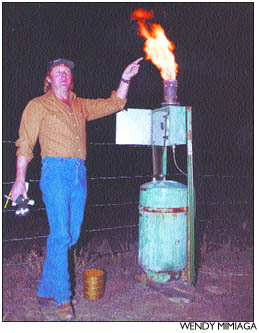|
Jan. 6, 2001 By Jim Mimiaga
This winter may seem dry so far, but experts say it is better than last year, and whether the scant snowfall trend will continue is impossible to tell yet. "Snotels" measuring snow depth around the San Juan Basin show this yearís winter snowpack at 76 percent of normal, reported John Porter, general manager of the Dolores Water Conservancy District. The í99/00 winter at this time was 17 percent of normal. "Itís too early to make any rash predictions, and farmers know thereís still plenty of time before itís all over," he said, noting that December showed up at 160 percent of normal, but as time goes on without significant storms, the average drops. Furthermore, Ski Hesperus, the local ski area plagued by a recent string of warm, dry winters, is actually open this season, although for how long is a question. Currently, a huge high-pressure system dominates the Western United States, essentially blocking jet-stream storms from the north, and allowing only occasional systems from the tropical south to squeeze through. One supposedly will bring some clouds to the Four Corners this weekend. National forecasts are not encouraging, however. Thirty- and 90-day outlooks show lower-than-normal precipitation for the Southwest and southeastern United States, prolonging both regionsí ongoing droughts. Warm winds from the south and southwest are ideal for this regionís cloud-seeding program, a technique that uses silver iodide to coax moisture out of clouds that otherwise might not drop snow onto regional watersheds and ski areas. Burned with a mixture of propane from five separately located generators, the silver iodide transforms into an acetone smoke made up of vaporized iodide that travels with a low-pressure systemís winds and into a cloud where they condense into ice crystals. If all goes as planned, the artificial crystals bond to minute water droplets, causing them to fall to earth sooner. "Most of the ice crystals are in the top of the cloud, so when the conditions are favorable this silver-iodide process helps ice crystals in the cloudís lower moisture level grow faster and fall out faster, increasing precipitation," said Larry Hjermstad of Western Weather Consultants, the company which conducts the system. Hjermstad makes the call to volunteers with equipment to fire up the simply-designed smokers when winds and air-moisture levels warrant cloud seeding. Typically, a few or all five of the generators are burned for 24-hour periods. They are located between Lizard Head Pass, Lone Cone, Cahone and Mancos. The DWCD pitched in $5,000 this winter for 375 hours of cloud-seeding from WWC, time that has almost expired, Porter said. (They can always buy more.) The Southwestern Water Conservancy District in La Plata County paid $25,000 for the technology and Purgatory Resort paid $20,000. Some critics are not convinced that seeding clouds to force more moisture fallout actually works. It is hard to quantify results. But for those that do (there are 45 programs across the country), it is the cheapest source of water available. "If youíre a believer, and I am, than it is the best deal on water you can get," Porter said. "A lot of the programs seed winter clouds and quite a few agricultural states use the technology, so why would they put out all that money if it didnít work?" The DWCD argues that cloud-seeding benefits the rafting season most in that it increases snowfall and therefore the chances of a McPhee Reservoir spill in the spring. Rafting advocates have disputed that claim, saying the DWCD overestimates cloud-seedingís benefits as justification for building the Plateau Creek dam, a proposal fervently opposed by the boating community, which believes it would further limit spills. Right now, McPhee is at its lowest level ever. There is 68,000 acre-feet of available water, compared to the previous lowest level of 87,000 acre-feet available in 1990. When full the lake can hold 229,000 acre-feet, but more than half of it is inactive storage that cannot be accessed. On the brighter side, all this sunny weather is great for working and playing outdoors. And the dramatically receded shoreline at McPhee has opened up some interesting hiking and bird-watching opportunities. |
||
|
Copyright © 2001 the Cortez Journal.
All rights reserved. |
